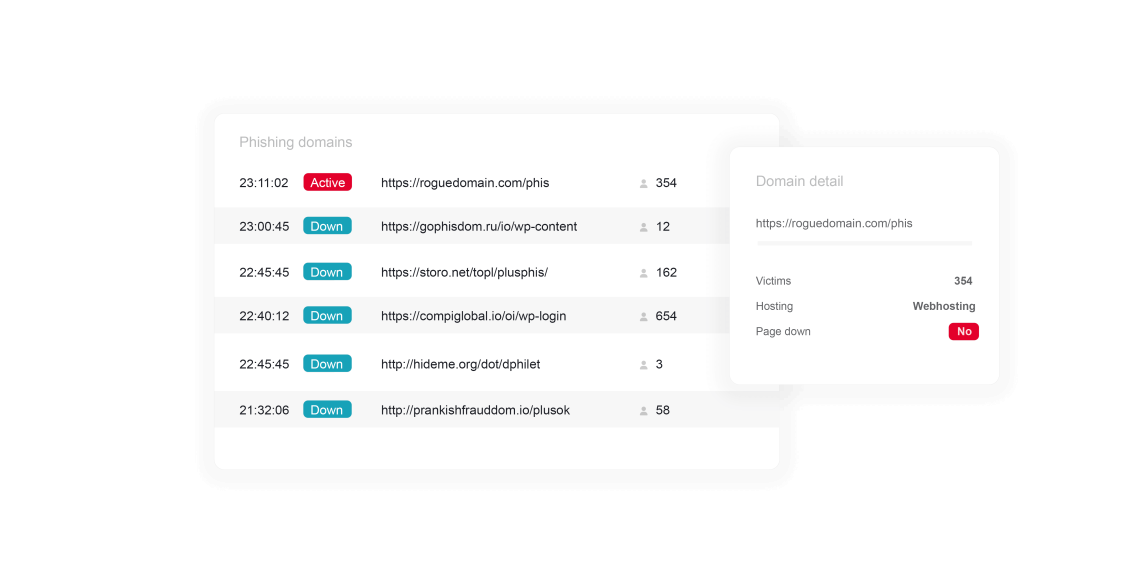Phishing Detection & Mitigation
Phishing is the primary catalyst for over 90% of cyber attacks.
Often manifesting through deceptive emails, texts, or phone calls, phishing attacks poses a significant threat to digital security. It involves tricking individuals into divulging personal and financial information, which fraudsters exploit for malicious activities and financial fraud. Limiting fraudsters’ opportunity to harvest sensitive data, effective phishing defense is key to maintaining digital safety and integrity.
Enhance your defense against phishing.
TALK TO A FRAUD FIGHTER
ThreatMark’s Cyber Fraud Fusion Center monitors the internet around the clock to bolster our customers’ defenses against phishing scams.
The CFFC’s primary role is continually scanning for and identifying phishing sites and suspicious digital activities. By doing so, phishing attempts targeting financial institutions and their customer are detected and mitigated, reducing the time these fraudulent sites are active and thus limiting their impact.
As evolving phishing tactics and trends are monitored, the CFFC gather gather intelligence about more sophisticated and responsive anti-phishing strategies. Continuous surveillance allows immediate action, such as alerting customers to new threats and beginning the phishing site takedown process. Playing a crucial role in bolstering security protocols, ThreatMark’s proactive approach supports the prevention of financial losses for customers and reinforces the overall trust in the financial institution’s commitment to digital security and customer protection.
Phishing attacks mitigated by ThreatMark.
-
973Phishing incidents detected in 2021.
-
5,233Phishing incidents detected in 2022.
-
9,154Phishing incidents detected in 2023.
(+75% Increase)

Detecting phishing attacks as they happen.

Phishing threats types and more.
-
What is credential theft?
Credential theft involves sophisticated phishing schemes where the customer is tricked into revealing sensitive information through seemingly legitimate emails or websites, such as usernames and passwords. Fraudsters then use the stolen credentials to gain unauthorized entry into customers' accounts, enabling them to carry out fraudulent transactions or steal personal data.
Learn More
-
What is a phishing site?
A phishing site is a deceptive website designed to trick users into disclosing sensitive information, such as usernames, passwords, or financial details. Phishing sites often mimic legitimate websites and employ social engineering tactics that exploit trust, leading users to unknowingly provide personal information to scammers.
-
What are common tactics used by phishing sites to trick users?
Along with phishing sites, scammers commonly use methods such as sending deceptive emails or messages to individuals. One example is a fraudulent text message claiming to be from a reputable delivery service, stating that a package is due with a link to track delivery. When the link is clicked, it directs the receiver to a fake website resembling the legitimate delivery company's site, prompting the input of personal information, such as name, address, or even payment details, under the guise of tracking or confirming a delivery.
FAQ: Phishing
-
Why is mitigating phishing important?
Phishing is the most common form of cyber-crime, estimated 3.4 billion spam emails sent daily. Additionally, an average of 1.4 million phishing sites are created every month*. Targeting all types of users, real-time detection and mitigation of phishing sites are crucial to safeguarding all digital interactions and preventing the misuse of stolen credentials.
*https://aag-it.com/the-latest-phishing-statistics/
-
Why do phishing attacks work?
The manipulative nature of phishing attacks targets what is most vulnerable: the human. The phishing site or message often employs urgency or fear to prompt immediate action, using fake login pages to capture sensitive information, making it a vicious method of social engineering.

40+ million online users protected.
ThreatMark’s Cyber Fraud Fusion Center stands at the forefront of fighting cyber threats, such as phishing and malware, with its expertise, tools, and intelligence.
Cyber Fraud Fusion Centre
-
Phishing Attacks & How to Prevent Them
Phishing is one of the most prevalent social engineering scams in the internet era.
This article attempts to present contemporary impact of phishing, it’s variations, some interesting trends ThreatMark discovered in 2020; and finally present a direction on how to prevent phishing scams.
Read More
-
The Phishers Favorite Pond
In an effort to keep our customers up to speed on the latest trends when it comes to fraud detection and prevention, ThreatMark presents our phishing blog series: Don’t Take the Bait!
Read More
Want to learn more about ThreatMark?
Complete our form to discover more about ThreatMark’s comprehensive approach to fraud disruption.

